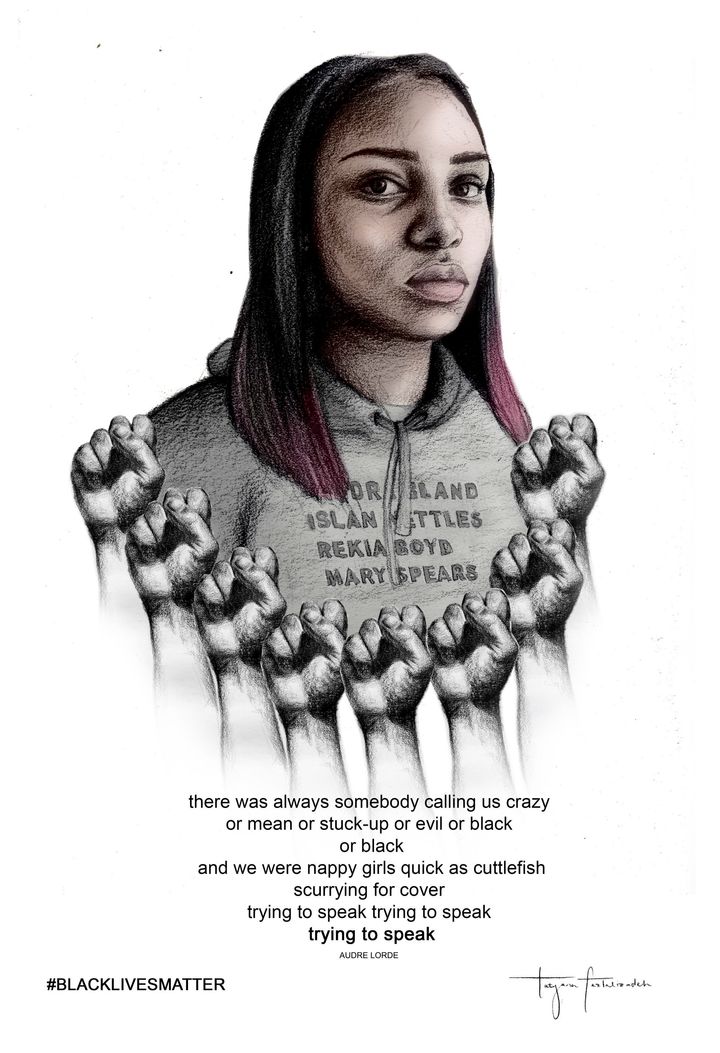
Last year many progressive Black people in the U.S. joked that if the worst happened in this election we would have to look for somewhere to live. Now, if anyone’s laughing about that, it’s to keep from crying. Most of us are not actually relocating to Canada (or as I would prefer, a majority-Black country in the Caribbean), but we still have to find a place and a way to live here and a life-giving relationship to the current moment. Even though it is not the first time our communities have faced blatant and insidious levels of oppression, we have to make it our home again. As Audre Lorde said, “we can make something out of anything.”
In 1964 when police violence in Harlem caused the community to explode, June Jordan, a new mother, thought about what it would take to make Harlem livable. Jordan took a deep look at the intersecting systems of oppression that made the literal corners of her neighborhood unsafe for Black children. But Jordan didn’t stop there, she drew up architectural plans for “Skyrise for Harlem” a Black feminist future, which she argued could start construction right away, where Harlem’s Black people of all ages could have green space, safe public spaces of connection and a physical life-scape that encouraged wonder and daydreams.
As Akasha Hull documents in Soul Talk, in the early 1980s after Ronald Reagan won a presidential campaign on a “welfare queen” platform that criminalized Black women in order to deprive all people of social programs, Black women turned to ancient spiritual practices to nourish and maintain their visionary activism, even as the political conditions seemed bleak.
“Black feminists used their living rooms as alternative spaces of media making and spilled from their stoops into the streets with creative responses to the threat of war.”
At the same time, Black feminists like Alexis De Veaux used their living rooms as alternative spaces of media making and spilled from their stoops into the streets with creative responses to the threat of nuclear war. De Veaux and other artists remembered the salon movement during the Harlem Renaissance and the Negritude movement and used the places where they lived as sites from which to transform the meaning of life in repressive times.
I think of all of these practices as what June Jordan called “living room” in her 1985 book of the same title, the intimate practice of making a livable world.
In the current moment, our communities are continuing to do what we have done for generations, creating housing, spiritual space to breathe and collective space to gather, without permission.
“Marginalized mothers are creating living room in their daily revolutionary mothering practices to make life happen.”
Right now, marginalized mothers are creating living room in their daily revolutionary mothering practices to make life happen.
The National Domestic Workers Alliance is making sure that domestic workers, the people working daily to make and sustain literal living room, can show up as leaders in our social justice movements.
People of color in Durham are collectively stewarding land to grow food, secure spiritual practice space and provide alternative housing.
Across North Carolina people are working together to make direct action spaces safer, more accessible and more child-inclusive, so people don’t have to choose between their roles in the home and their expression of outrage in the streets.
People of color in Detroit and New Orleans are using living rooms as visionary fiction incubators to dream a new world.
Alexis De Veaux and Sokari Ekine are STILL creating revolutionary living room salons for Black queer community building and creative elevation in Brooklyn.
The Movement for Black Lives and Black Organizing for Dignity and Power are incorporating deep spiritual and physical awareness into Black-led front-line organizing.
And here where I sit writing this, Mobile Homecoming is building spiritually transformative sustainable intergenerational gathering and living space one living room and one tiny house at a time.
We cannot escape this moment. But we do have to find a place and a way to live. As June Jordan said, “It is time to make our way home.”
This post is part of the Black Futures Month blog series brought to you by The Huffington Post and the Black Lives Matter Network. Each day in February, look for a new post exploring cultural and political issues affecting the Black community and examining the impact it will have going forward. For more Black History Month content, check out Black Voices’ ‘We, Too, Are America’ coverage.
